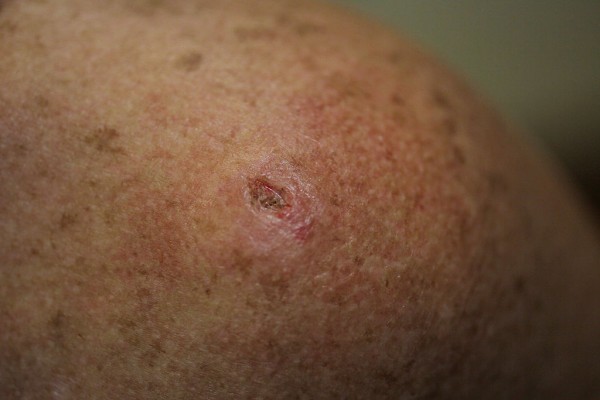Skin cancer is the abnormal growth of skin cells and most often develop on parts of the skin that get the most exposure from the sun. The common areas that suffer from skin cancer are the face, chest, arms, and hands. That doesn't mean that unexposed skin is not susceptible. Skin cancer can also hit the neck, bottoms of the feet, genitals and under the fingernails. Skin cancer usually starts with a suspicious mole, freckle, or spot, especially if they start to grow bigger or multiply. Skin cancer is highly treatable, especially if caught early. It is also not contagious.
According to the Mayo Clinic, there are three major types of skin cancer:
Basal Cell Carcinoma
 (Photo: Joe Raedle / Getty Images)
(Photo: Joe Raedle / Getty Images)Biopsy. A skin sample is taken from a woman constantly exposed to the sun's UV rays.
The American Academy of Dermatology Association classifies Basal Cell Carcinoma as the most common type of skin cancer. BCC most frequently happens to people with fair skin and develops after years of constant sun exposure or indoor tanning. BCCs are usually found in the head, neck and arms but can form anywhere on the body. BBCs often appear as flesh-colored round growths, shiny bumps that can be red, pink, or white, lesions that can brown, black or blue or flat and scaly red patches that grow over time. If left unattended, it can penetrate the nerves, muscles and bones and cause disfigurement. Early detection, diagnosis and treatment is crucial.
Also read: Red Spots on Skin: Symptoms You Need to Look Out For
Squamous Cell Carcinoma
 (Photo: American Cancer Society/Getty Images)
(Photo: American Cancer Society/Getty Images)Squamous Cell Carcinoma can appear as red bumps on the skin.
Squamous Cell Carcinoma is the second most common type of skin cancer. While it can be aggressive, it's usually not life-threatening. However, if left untreated, it can grow and spread to other parts of the body and cause complications. Like BCC, SCC also comes from chronic sun exposure and frequent visits to tanning salons. People with fair skin are also the most vulnerable, but people with darker skin are not exempt. SCC appears in the form of red bumps, scaly patches or sores that heal and re-open. If you have sores or scabs that do not heal in a span of two months or have found patches of scaly skin that do not go away, set an appointment with your doctor.
Melanoma
 (Photo: American Cancer Society/Getty Images)
(Photo: American Cancer Society/Getty Images)This is a close up of a malignant melanoma.
Often called the most serious type of skin cancer, melanoma has the highest tendency to spread. It can develop within moles that you already have or suddenly appear as unique dark spots. In men, it often appears on the face or the trunk. In women, it can usually be found on the lower legs. You don't often have to be exposed to the sun to develop melanoma. For people with darker skin tones, it tends to occur on the palms and soles, or under the fingernails and toenails. Physical manifestations of melanoma include large brown spots with darker specks, moles that bleed, change in color or increase in size, lesions that have irregular borders and feels itchy or have a burning sensation, and dark lesions that appear on your palms, soles, fingertips, mouth, nose, genital or anus.
If you are constantly under the sun, work in radiation labs, have a love of tanning or immuno-compromised, be on the lookout for suspicious skin irregularities. The early detection and treatment of any type of skin cancer is crucial to your health.
Related article: Why is it Recommended to Check for Skin Cancer Early?


